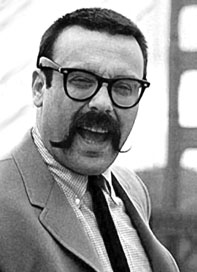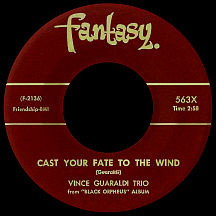VINCE GUARALDI TRIO
Cast Your Fate to the Wind
Black Orpheus, set against the colorful Carnaval of Rio de Janeiro, was directed by Frenchman Marcel Camus and won the 1959 Cannes Film Festival's Palme d'Or in addition to the Oscar for Best Foreign Language Film. The music of Brazilian culture is predictably evident in the movie's soundtrack by Rio-born composers Antonio Carlos Jobim and Luiz Bonfá, which includes subtle strains of the bossa nova rhythms already extending beyond South America's largest nation to many points on the globe; the infectious 2/4 beat would soon be gaining popularity in the U.S. through recordings by "Desafinado" saxophonist Stan Getz and others. Pianist Vince Guaraldi, a San Francisco native fiercely loyal to his North Beach digs who'd begun his career more than a half-decade earlier, was influenced but not overwhelmed by bossa nova; his album Jazz Impressions of Black Orpheus arrived in 1962, nearly three years after the acclaimed movie had made its mark. The four tracks on side one were adapted from the Jobim-Bonfá score, while side two consisted of random selections including Guaraldi's own composition, "Cast Your Fate to the Wind." It was the first of two great career claims-to-fame he would enjoy during his lifetime.
A piano-pounding boogie-woogie-style player in his early days, Vince took any gig that was offered, such that experience came quickly while technique in the subtleties of jazz evolved more gradually. He put most of it on hold after Uncle Sam tapped him for Army duty during the Korean War; after returning home, he did some part time playing at the Black Hawk nightclub, a favorite spot where the nation's biggest jazz stars regularly displayed their skills. In 1953, at age 25, Vince could be heard for the first time in the grooves of a vinyl disc as a fill-in pianist on vibraphonist and former Brubeck Trio drummer Cal Tjader's Fantasy Records debut, The Cal Tjader Trio. Within two years, Guaraldi formed his own trio with pal Eddie Duran on guitar and Dean Reilly on bass. They worked the S.F. club scene, the famous Hungry i included.
Vince took part in an album project for Fantasy, contributing two tracks to Modern Music from San Francisco with saxophonist Jerry Dodgion, bassist Eugene Wright and drummer John Markham, appearing as the Vince Guaraldi Quartet (a trio led by original Brubeck sideman Ron Crotty and a separate quartet led by Dodgion supplied the set's other five selections). Vince, Eddie and Dean continued doing live shows together and archived their unique vibe on two albums, The Vince Guaraldi Trio in '56 and A Flower is a Lovesome Thing in '57, though the majority of Guaraldi's recordings in the 1950s were with Tjader's outfit. Arguably the highlight during the decade for Vince was a hot midnight jam with Cal's sextet during the very first Monterey Jazz Festival held in the coastal California city in October 1958.
Back in the studio in '62 with a new trio (Monte Budwig on bass and Colin Bailey on drums), Guaraldi committed his own arrangements to disc of some of the music from Black Orpheus, an unusual choice that accidentally and rapidly moved the mustachioed maestro a few notches up the rung. The album hit stores around summer's end and "Samba de Orpheus" was released as a 45, a hard sell at radio until the programming whiz kids at Sacramento's top 40 outlet KROY recognized the brilliance of the single's flip side and started giving it frequent spins. Though influenced somewhat by bossa nova, "Cast Your Fate to the Wind" employs shifting time signatures, while at points in the song Vince created a short piano roll by using his fist! Spending four months on the national singles charts from December 1962 to April '63, Guaraldi's unique musical work became the first hit single for the 13-year-old Fantasy label.
As sales of Jazz Impressions of Black Orpheus increased, the title on the album's cover kept changing: first it had no mention of "Cast Your Fate," then it was shown in small print and finally in large print above the album's title. In May of '63 the song won a Grammy for Vince as Best Original Jazz Composition. Two years later, a remake by British group Sounds Orchestral added strings to the arrangement and reached the top ten, while vocal versions by Steve Alaimo and Shelby Flint, with lyrics by one-and-done songwriter Carel Werber, charted over the next year. Demand dictated Vince do his signature song every time he performed in public...and he didn't mind one bit!

A number of TV specials were produced by KQED channel 9, San Francisco's public-funded educational station, often with the involvement of noted music critic Ralph J. Gleason. The shows featured Guaraldi with his trio and guest musicians like Brazilian guitar man Bola Sete (who'd previously worked with jazz great Lalo Schifrin and gained attention in the U.S. after appearing at the 1962 Newport Jazz Festival). Vince and his new buddy Bola recorded and appeared together often over the next few years. Guaraldi conformed to the standard bossa nova rhythm on his "Cast" follow-up, "Zelao," and backed singer Ella Jamerson's vocal rendition of Buddy Johnson's "Since I Fell For You" (covering the late-'63 hit version by Lenny Welch) on Fantasy sister label Galaxy. But another hit single wasn't in the cards; something more substantial waited in the wings that would utimately keep his music in the mainstream while providing a certain measure of immortality.
Many musical projects kept Vince busy. His concert at San Francisco's Grace Cathedral in May 1965 was a spectacular offering of original music backed by a 68-voice choir (Fantasy issued an album and a single, "Theme to Grace"). But destiny had already dropped him into the same bag with a group of comic characters who'd been part of newspaper readers' daily routines since 1950. TV producer Lee Mendelson (who acknowledged "Cast Your Fate to the Wind" as one of his favorite songs) asked Guaraldi to compose and perform a music soundtrack for a documentary on cartoonist Charles Schulz's Peanuts strip...a program that never aired. A single was, nevertheless, released on Fantasy in late 1964, pairing the bouncy "Linus and Lucy" with the more laid-back "Oh, Good Grief." What could have been an enjoyable but largely pointless exercise instead had a colossal impact on the worlds of jazz and children's music. Mendelson sold CBS on the idea of a 30 minute Charlie Brown Christmas special and Coca Cola jumped at the chance to sponsor it; the services of Guaraldi and animation artist Bill Melendez, who'd worked on the documentary, were retained for the program, which premiered on December 9, 1965 to huge ratings. "Christmas Time is Here," penned by Guaraldi and sung by a children's choir, has become a standard. The show won an Emmy for Best Children's Program and has been broadcast every year since, while literally dozens of Peanuts/Charlie Brown television specials have added to the legacy of Schulz's creation.
It seemed as though Charlie, Schroeder, Peppermint Patty and the gang (Snoopy too!) consumed most of Vince's time; a feature film, A Boy Named Charlie Brown, landed a 1970 Oscar nomination for Guaraldi, Mendelson, Rod McKuen, John Scott Trotter and Alan Shean in the Best Original Song Score category and four Grammy noms for the TV installments were added to Vince's list. He continued performing (occasionally joining The Grateful Dead in concert) and was a regular at San Francisco clubs in the early '70s, but after a brief stint with Warner Bros. Records did little recording other than the Charlie Brown projects. A shocking end to the story: in February 1976, during a break in a performance at Butterfield's nightclub in Menlo Park, 47-year-old Vince had a heart attack and died. His famous cartoon theme "Linus and Lucy" was played at the funeral. An unthinkable thought: if "Cast Your Fate to the Wind" hadn't gotten stuck in Lee Mendelson's head back in '63, there probably never would have been any clever Vince Guaraldi "Peanuts" tunes to listen to and enjoy with your kids.


